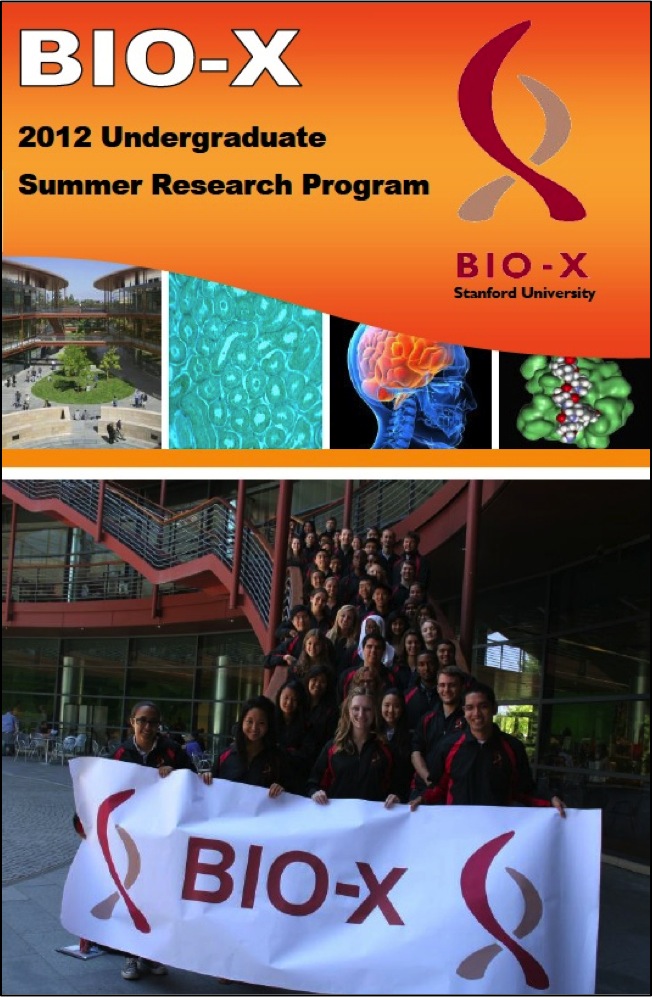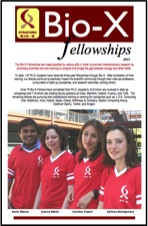
Welcome to the biweekly electronic newsletter from Stanford Bio-X for members of the Bio-X Corporate Forum. Please contact us if you would like to be added or removed from this distribution list, or if you have any questions about Stanford Bio-X or Stanford University.
Seed Grants
 SEED GRANTS FOR SUCCESS - Stanford Bio-X Interdisciplinary Initiatives Program (IIP)
SEED GRANTS FOR SUCCESS - Stanford Bio-X Interdisciplinary Initiatives Program (IIP)
The Bio-X Interdisciplinary Initiatives Program represents a key Stanford Initiative to address challenges in human health. The IIP awards approximately $3 million every other year in the form of two-year grants averaging about $150,000 each. From its inception in 2000 through the fifth round in 2010, the program has provided critical early-stage funding to 114 different interdisciplinary projects, involving collaborations from over 300 faculty members, and creating over 450 teams from five different Stanford schools. From just the first 5 rounds, the IIP awards have resulted in a 10-fold-plus return on investment, as well as hundreds of publications, dozens of patents filed, and most importantly, the acceleration of scientific discovery and innovation.
In 2012, Stanford Bio-X selected 23 new seed grant projects as the winners of the 6th round. Please go here to view the list of awardees, along with the titles of their projects and the abstracts of the research. Competition was intense as the awardees were chosen from 118 Letters of Intent (LOIs). Selection criteria included innovation, high-reward, and interdisciplinary collaboration. (To view the 114 other IIP projects that have been funded from the first 5 rounds, please click here.) In addition, SANOFI has also funded 4 new Bio-X IIP Seed Grant projects from round 6!
LAST MONDAY, Bio-X had its second annual IIP Symposium of the year at the Clark Center, which highlights projects that exemplify the Stanford Bio-X mission of crossing boundaries to bring about interdisciplinary research and solutions in the field of life bioscience. The symposium was a huge success with over 300 people attending this event, which included 8 oral presentations and 136 poster presentations. Recorded talks from the symposium will be uploaded soon. If you'd like to view the talks for previous symposia through the years, please click here.
We are cultivating and are highly successful in building meaningful collaborations with numerous corporate colleagues. New collaborations through our seed grant projects are highly encouraged. To learn about how to get involved, please contact Dr. Hanwei Li or Dr. Heideh Fattaey.
Fellowships
Every year, graduate students and postdoctoral scholars of Bio-X affiliated faculty are highly encouraged to apply for the Bio-X Fellowships, which are awarded to research projects that are interdisciplinary and utilize the technologies of different fields to solve different biological questions. Students are encouraged to work collaboratively with professors of different departments, thus creating cross-disciplinary relationships among the different Stanford schools. Our fellows have conducted exciting research, resulting in publications in high-impact journals and have been offered excellent positions in industry and academia. To date, Stanford Bio-X has a total of 152 Fellows.
On June 26th, Bio-X held its annual Bio-X Fellows Symposium, where there were four 15-minute oral presentations followed by one-minute spiels from current fellows. The 25 newest fellows selected this year were also announced, and about 100 attendees came to the symposium. Please click on the "Bio-X Fellows Symposium" link above for the agenda and titles of the talks, and on the icon of the brochure above for the updated and latest Bio-X Fellowships brochure.
To view the numerous projects that have been awarded over the years, please click here.
 BIO-X UNDERGRADUATE SUMMER RESEARCH PROGRAM
BIO-X UNDERGRADUATE SUMMER RESEARCH PROGRAM
The Bio-X Undergraduate Summer Research Program supports undergraduate research training through an award designed to support interdisciplinary undergraduate summer research projects. The program is an invaluable opportunity for students to conduct hands-on research, learn how to carry out experiments in the laboratory, and develop the skills to read and analyze scientific literature.
This program is eligible to Stanford students who want to work in the labs of Bio-X affiliated faculty. To date, 176 students have been awarded the opportunity to participate in the Bio-X Undergraduate Summer Research Program. This summer is Stanford Bio-X's 8th round of USRP.
Participating undergraduates are also required to present poster presentations on the research that they've conducted during the program. Please click here for title lists of past posters that our undergraduates have presented.
Many fruitful collaborations and relationships have been established with industry through fellowships. Please contact Dr. Hanwei Li or Dr. Heideh Fattaey if you'd like to learn more about how to get involved with these fellowship programs.
News
 Stanford-developed collagen patch speeds repair of damaged heart tissue in mice
Stanford-developed collagen patch speeds repair of damaged heart tissue in mice
Bio-X Affiliated Faculty Pilar Ruiz-Lozano, Daniel Bernstein, Manish Butte
Bio-X IIP Seed Grant Support
You can't resurrect a dead cell any more than you can breathe life into a brick, regardless of what you may have gleaned from zombie movies and Dr. Frankenstein. So when heart cells die from lack of blood flow during a heart attack, replacing those dead cells is vital to the heart muscle's recovery. But muscle tissue in the adult human heart has a limited capacity to heal, which has spurred researchers to try to give the healing process a boost. Various methods of transplanting healthy cells into a damaged heart have been tried, but have yet to yield consistent success in promoting healing. Now, researchers at the Stanford University School of Medicine and Lucile Packard Children's Hospital have developed a patch composed of structurally modified collagen that can be grafted onto damaged heart tissue. Their studies in mice have demonstrated that the patch not only speeds generation of new cells and blood vessels in the damaged area, it also limits the degree of tissue damage resulting from the original trauma. The key, according to Pilar Ruiz-Lozano, PhD, associate professor of pediatrics, is that the patch doesn't seek to replace the dead heart-muscle cells. Instead, it replaces the epicardium, the outer layer of heart tissue, which is not muscle tissue, but which protects and supports the heart muscle, or myocardium. "This synthetic tissue has the mechanical properties of the embryonic epicardium," said Ruiz-Lozano, who is the senior author of a study that describes the researchers' findings. The study was published online Aug. 29 in Biomaterials. Vahid Serpooshan, PhD, a postdoctoral scholar in cardiology, is the lead author.
 Scientists show how antibiotics enable pathogenic gut infections
Scientists show how antibiotics enable pathogenic gut infections
Bio-X Affiliated Faculty Justin Sonnenburg
A new study by researchers at the Stanford University School of Medicine could help pinpoint ways to counter the effects of the antibiotics-driven depletion of friendly, gut-dwelling bacteria. A number of intestinal pathogens can cause problems after antibiotic administration, said Justin Sonnenburg, PhD, assistant professor of microbiology and immunology and the senior author of the study, published online Sept. 1 in Nature. Graduate students Katharine Ng and Jessica Ferreyra shared lead authorship. “Antibiotics open the door for these pathogens to take hold. But how, exactly, that occurs hasn’t been well understood,” Sonnenburg said. In the first 24 hours after administration of oral antibiotics, a spike in carbohydrate availability takes place in the gut, the study says. This transient nutrient surplus, combined with the reduction of friendly gut-dwelling bacteria due to antibiotics, permits at least two potentially deadly pathogens to get a toehold in that otherwise more forbidding environment.
Blocking molecular pathway reverses pulmonary hypertension in rats, study finds
Medicine Faculty Mark Nicolls
Pulmonary hypertension, a deadly form of high blood pressure that develops in the lungs, may be caused by an inflammation-producing molecular pathway that damages the inner lining of blood vessels, according to a new study by researchers at the Stanford University School of Medicine. The results, published Aug. 28 in Science Translational Medicine, suggest that using medications to block this pathway could lead to the first-known cure for the disease, apart from lung transplantation. The new research could also lead to a better understanding of other diseases involving inflammation of blood vessels, such as coronary artery disease, said Mark Nicolls, MD, senior author of the study and division chief of pulmonary and critical care medicine at Stanford, as well as a staff physician at the Veterans Affairs Palo Alto Health Care System. "We believe that targeting inflammation is an exciting approach to augment current treatments for pulmonary hypertension because it may reverse the underlying cause of the disease," said Nicolls, who is also director of the Lung Immunology Program and an associate professor of medicine. "We believe this is going to be an approach that helps a large number of patients."
 State stem cell grant will fund muscular dystrophy work
State stem cell grant will fund muscular dystrophy work
Bio-X Affiliated Faculty Michele Calos
Michele Calos, PhD, professor of genetics at the School of Medicine, has been awarded $1.9 million from the California Institute for Regenerative Medicine to develop a stem cell-based therapy for a muscle disease called limb-girdle muscular dystrophy type 2B. The award was part of $40 million distributed today to researchers at 10 institutions to enable the rapid movement of promising, basic stem cell science out of the laboratory and into clinical applications. "These awards are moving discoveries into the clinical pipeline for patients" CIRM president Alan Trounson, PhD, said in a prepared statement. "The strategies are focused on problems where we think there is a very reasonable chance that they will evolve into clinical studies for treating some of the worst diseases we have in the community."
Events
| Genetics Sept 6, 2013, 12 pm - 1 pm Li Ka Shing Center, Room 120, Stanford, CA "Genetics of Complex Pediatric Disorders" Speaker: Hakon Hakonarson, MD, PhD, Center for Applied Genomics, Children's Hosp. PA |
Nanobiotechnology Seminar September 12, 2013, 5:30 pm - 6:30 pm Munzer Auditorium, Stanford, CA "Cell Sorting and Directed Evoluation in Microfluidic Systems" Speaker: Hyongsok (Tom) Soh, PhD, UCSB |
Resources
| Stanford University |
| Stanford Bio-X |
| Bio-X Seed Grants The Stanford Bio-X Interdisciplinary Initiatives Program (IIP) provides seed funding for high-risk, high-reward, collaborative projects across the university, and have been highly successful in fostering transformative research. |
| Office of Technology and Licensing "Techfinder" Search the OTL Technology Portal to find technologies available for licensing from Stanford. |
| Stanford Center for Professional Development - Take advantage of your FREE membership! - Take online graduate courses in engineering, leadership and management, bioscience, and more. - Register for free webinars and seminars, and gets discounts on courses. |
| Stanford Biodesign Video Tutorials on how FDA approves medical devices A series of video briefs recently produced by the Stanford Biodesign Program teaches innovators how to get a medical device approved for use in the United States. This free, online library of 60 videos provides detailed information on the Food and Drug Administration regulatory process, short case studies and advice on interacting with the FDA. |
To learn more about Stanford Bio-X or Stanford University, please contact Dr. Hanwei Li, the Bio-X Corporate Forum Liaison, at 650-725-1523 or lhanwei1@stanford.edu, or Dr. Heideh Fattaey, the Executive Director of Bio-X Operations and Programs, at 650-799-1608 or hfattaey@stanford.edu.


